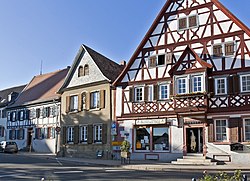Westhofen
| Westhofen | ||
|---|---|---|

Old houses on the town square
|
||
|
||
| Coordinates: 49°42′16″N 8°14′53″E / 49.70444°N 8.24806°ECoordinates: 49°42′16″N 8°14′53″E / 49.70444°N 8.24806°E | ||
| Country | Germany | |
| State | Rhineland-Palatinate | |
| District | Alzey-Worms | |
| Municipal assoc. | Wonnegau | |
| Government | ||
| • Mayor | Hans-Werner Balz | |
| Area | ||
| • Total | 14.73 km2 (5.69 sq mi) | |
| Elevation | 121 m (397 ft) | |
| Population (2015-12-31) | ||
| • Total | 3,206 | |
| • Density | 220/km2 (560/sq mi) | |
| Time zone | CET/CEST (UTC+1/+2) | |
| Postal codes | 67593 | |
| Dialling codes | 06244 | |
| Vehicle registration | AZ | |
| Website | www.gemeinde-westhofen.de | |
Westhofen is an Ortsgemeinde – a municipality belonging to a Verbandsgemeinde, a kind of collective municipality – in the Alzey-Worms district in Rhineland-Palatinate, Germany.
Westhofen lies between Worms (roughly 12 km to the southeast), Mainz and Alzey in Rhenish Hesse and is part of the Verbandsgemeinde Wonnegau.
In Westhofen rises the Seebach, Rhenish Hesse’s strongest spring. It is also the only spring in the region that rises in a valley. It is fed by groundwater from the Donnersberg area.
Westhofen had its first documentary mention as far back as Carolingian times and was granted market rights in 1324. Westhofen’s importance in earlier times can be seen in the ring of defences around the village, which are still preserved, and which include a wall and several dykes.
The council is made up of 20 council members, who were elected at the municipal election held on 7 June 2009, and the honorary mayor as chairman.
The municipal election held on 7 June 2009 yielded the following results:
The municipality’s arms might be described thus: Argent six grapeleaves conjoined at the fess point in pale, bend and bend sinister, all vert, growing on which three bunches of grapes azure.
The motif displayed in the charges, of course, symbolizes Westhofen’s most important industry, winegrowing. Similar compositions can be seen in municipal seals dating back to the 15th century, although a coat of arms appearing in the Kaffee HAG albums in the 1920s shows a somewhat different composition, although it is the same motif. That showed a full vine, not only leaves, and a small, fourth bunch with only three grapes.
Moreover, beginning in 1615, Westhofen was part of Electoral Palatinate and adopted the Palatine Lion as a charge in its arms. He held a bunch of grapes in his paw. That has not been retained in the modern arms.
...
Wikipedia



